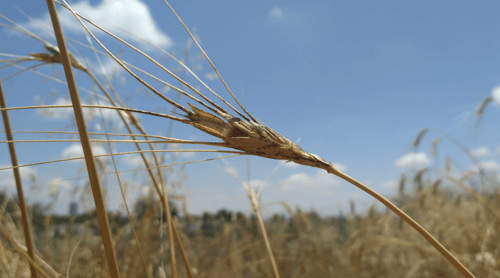Researchers from Tel Aviv University succeeded in sequencing the wild wheat genome. In the research, mutations were discovered that allow humans to grow wheat for 10,000 years

We are all familiar with the spectacular sight of a wheat field waiting to be harvested, all of it standing upright and loaded with kernels. Allegedly - one of the most ancient and natural sights in the world. Well, it turns out that it is not so: according to the scientists, the combined crops are a product of the cultivation of wheat by man with the development of agriculture, only about 10,000 years ago. This feature is the main difference between the cultivated wheat that is harvested by man, and its ancestral mother, the wild wheat - whose ears break up and spread the seeds in all directions, so that they germinate at some distance from each other in the next rainy season.
In a groundbreaking study, researchers at the Cereal Research Institute of Tel Aviv University's Faculty of Life Sciences, led by Dr. Assaf Distelfeld, have now succeeded in sequencing the wild wheat genome, and locating in it two genetic mutations responsible for the characteristic of the combined oats. "We found that these two mutations are present in all cultivars of cultivated wheat that are grown around the world today, but are not present in wild wheat," says Dr. Distelfeld. "Both mutations are just like a logo, a trademark of cultivated wheat."
The research was carried out with the Israeli company NRGene of Menes Ziona, and with leading laboratories in Germany, Italy, Canada, Israel and the USA. It was published in the scientific journal Science - one of the most prestigious and important in the world.
The beginning of the research in the cracking of the wild wheat genome with the help of an innovative algorithm of the Israeli company NRGene Menes Ziona. "The wheat genome is considered one of the most complex in nature - 17 billion building blocks (nucleotides/letters) in bread wheat and 12 billion in wild wheat and durum wheat (pasta) - compared to only 3 billion in the human genome," says Dr. Distelfeld. "During the last decade, researchers all over the world, backed by huge budgets, tried to sequence the wheat genome, but the results were only partial. NRGene's technology allowed us at Tel Aviv University, with relatively limited budgets, to finally put together the puzzle of the wild wheat genome."
Doctoral student Raz Avni, one of the authors of the study, explains: "When you sequence the DNA using conventional technology, you get a large number of short DNA sequences, 250 building blocks (letters) long each. NRGene's software allowed us to build much longer sequences from these short sequences - 7,000,000 building blocks on average. Now we wanted to arrange the long sequences in the correct order, in order to build the complete genome. For this purpose, we developed in our laboratory what is known in science as a 'genetic population': 150 individuals that are descendants of two parents, cultivated wheat and wild wheat. We mapped this population with the help of thousands of genetic markers, and created from them a kind of 'anchors', which outlined the order in which the long sequences were assembled. In the end we built about 90% of the wild wheat genome: about 10.5 billion building blocks that contain 65,000 genes (compared to 20,000 genes in the human genome)."

Now the researchers approached the following question: what is the role of the various genes, and above all, which are the genes responsible for properties that are unique to wheat? "The first feature we looked for in the genome was the one that differentiates the cultivated wheat from the wild wheat: the union of the seeds in the ears versus the disintegration of the ears and the dispersal of the seeds," says Dr. Distelfeld. "For this purpose, we divided our genetic population into several groups: plants that inherited the trait of the crop association, compared to those whose crops decompose or partially decompose. A comparison between the DNA of the different groups revealed two specific mutations, which are only found in wheat with combined oats."
To verify that these are indeed the mutations responsible for wheat cultivation in the early days of agriculture, doctoral student Moran Neve examined 113 wild wheat plants from various places in the Middle East - from Israel to Turkey, Iran, Iraq and Syria, against 94 varieties of cultivated wheat from around the world. And the results were unequivocal: the two mutations were found in all cultivated wheat varieties, and in none of the wild wheat.
"For us, this is only the first step," concludes Dr. Distelfeld. "Using the tools we have today, and have even been distributed to the whole world, we can also locate in the wheat genome genes responsible for additional properties - such as nutritional value, production (yield), resistance to pests, resistance to changing climate conditions such as cold, heat and dryness, and more. This information is expected to serve as an essential basis for the future improvement of the wheat varieties grown by man - as a central answer to a most critical challenge: feeding humanity in the 21st century."
